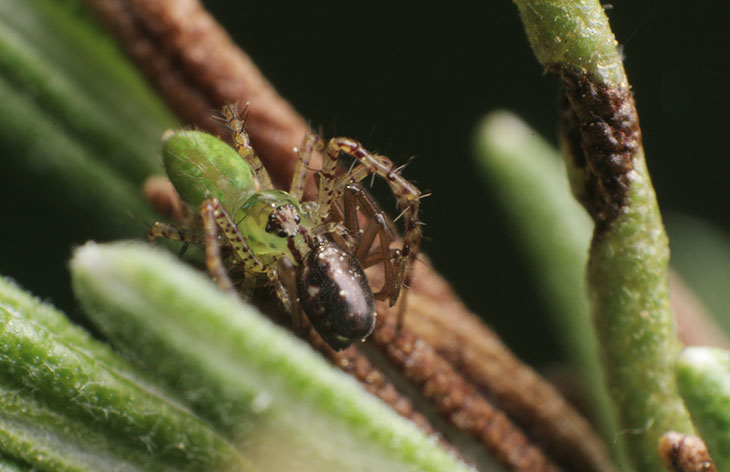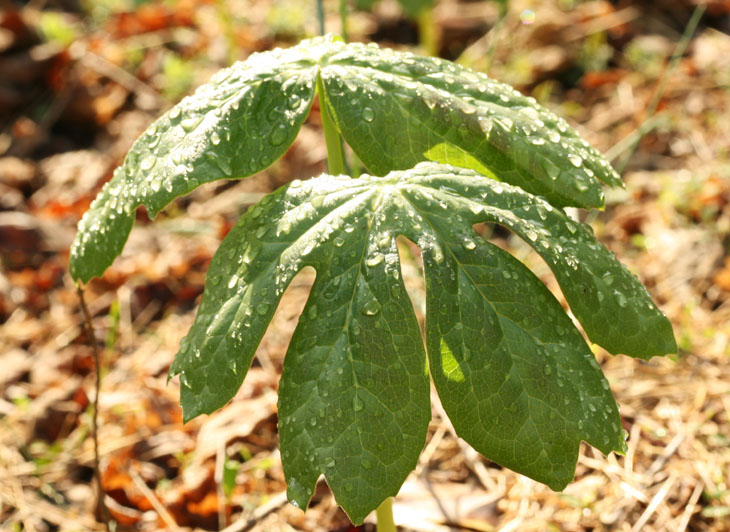
I got out to poke around down at the park a few times in the past couple of weeks, the same park that produced the great chorus frog recording last month. There was a primary reason for this, as I’ll get to shortly.
The image above I included mostly for the counterpoint to the tulip plant I featured previously. The leaves of those had been so water-repellent it was freaky, but this plant was just the opposite – I’m pretty sure this is a mayapple, Podophyllum peltatum. It had rained sometime before sunrise, hours before this image was taken, and most plants had shed the raindrops long before, but this one was displaying them proudly, despite the drooping angle of the leaves. This load of raindrops made them conspicuously different from everything else around.
 What I have been mostly after was more detail shots of praying mantids hatching, and the park hosts several egg cases in locations I’ve memorized now. So far, no luck – one definitely displayed the debris that told me I was too late, and a couple of others seem to indicate likewise, but I’m still holding out hope I can add some nice images this year. But while there, I grabbed some other frames as I explored.
What I have been mostly after was more detail shots of praying mantids hatching, and the park hosts several egg cases in locations I’ve memorized now. So far, no luck – one definitely displayed the debris that told me I was too late, and a couple of others seem to indicate likewise, but I’m still holding out hope I can add some nice images this year. But while there, I grabbed some other frames as I explored.
I tried to determine what this tree was, with no luck at all, but I’m not too concerned – I just liked the shape of the lone blossom, as well as the position of the branches against the sky. This is typical of many trees right now, which are starting to bud out in earnest – the ones I captured close to two months ago are the earliest starters, appearing well ahead of anything else in the area. The leaves are breaking out on most of the deciduous trees now, finally making wider, landscape-style shots possible, and not as stark and bare as the background visible here. The area also hosts a serious population of loblolly pines, but these are longneedle trees, the kind that are used for telephone poles, and they tend to lose all branches and needles down low as they grow, leaving only a green crown at the top. I’ve said it before: they’re ugly trees, hardly qualifying as ‘evergreens,’ and even a dense stand of them won’t appear healthy and vibrant. If you live in an area with firs and spruce, be grateful – at least you have something to photograph in the colder months.
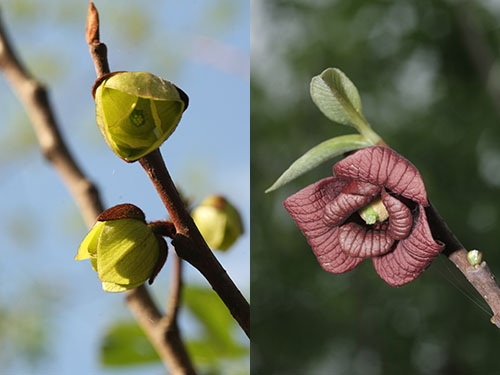 I’ll provide a couple more images of those blossoms, taken only a few days apart – if you know what these are, feel free to comment. I tried numerous different search terms for the color of the latter stages seen here and couldn’t turn up anything at all. Of course, I’m a guy, so my color vocabulary is limited – I resisted the urge to call these “beef-colored.” The leaves haven’t developed far enough yet to use as a guide, and even searching under “inverted flowers” turned up nothing that looked close. Trees have never been my thing.
I’ll provide a couple more images of those blossoms, taken only a few days apart – if you know what these are, feel free to comment. I tried numerous different search terms for the color of the latter stages seen here and couldn’t turn up anything at all. Of course, I’m a guy, so my color vocabulary is limited – I resisted the urge to call these “beef-colored.” The leaves haven’t developed far enough yet to use as a guide, and even searching under “inverted flowers” turned up nothing that looked close. Trees have never been my thing.
The small pond in the park is now populated, and I use that word with reckless understatement, by tadpoles right now. Last year I had visited during the frenzy of mating season, and this year we can see the result of such unbridled passion.
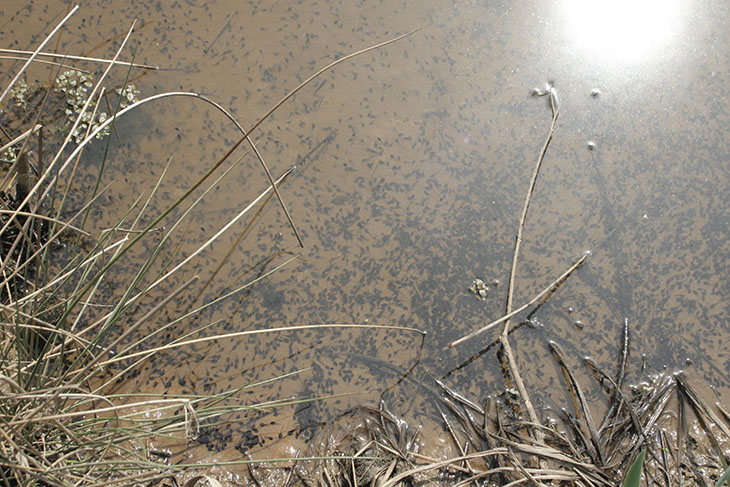
The pond is maybe six by twenty meters and very shallow, really just a stormwater catch basin, but it meets with amphibian approval. Then again, so does a deep puddle, so this accolade is of limited use. I couldn’t begin to estimate the number of tadpoles within, but it easily numbers in the tens of thousands. While it would be nice to provide some development shots as they transition into toads or frogs, I may be competing against the herons who do not appear to have discovered this bounty yet. The numbers will dwindle drastically in the coming weeks, so we’ll see what happens.
I couldn’t pass up another image, but can you blame me?
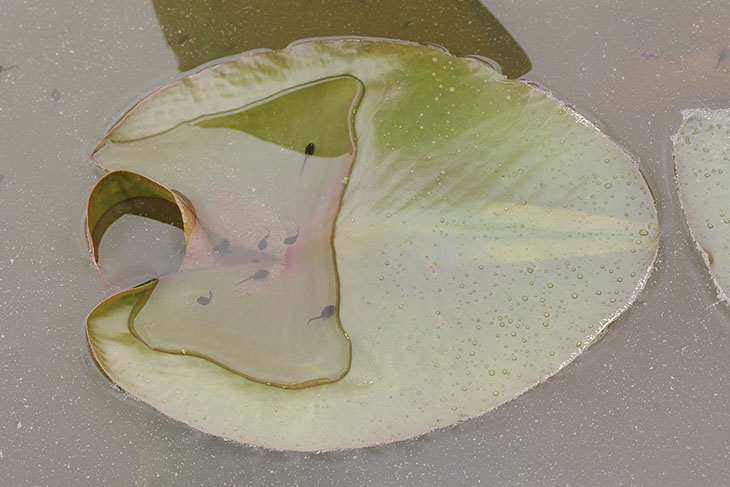
And I’ll throw in a couple of frames grabbed while out with a student; immediately below are the dogwood blossoms that North Carolina is so proud of, but I have no idea what’s below that, except to say that the pink coloration in the background comes from a redbud tree.

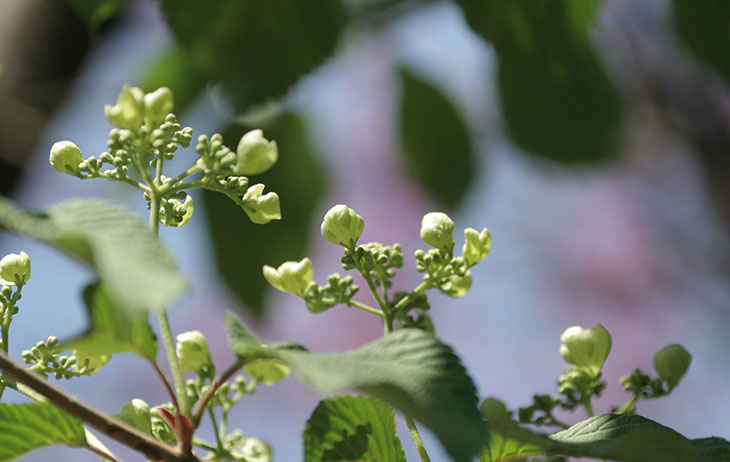
Speaking of redbuds, I was pleased to see the eastern redbud tree (Cercis canadensis,) which I’d had to transplant last fall from alongside the porch right next to the azaleas, has taken the move without difficulty and is now leafing out, also producing its namesake flowers for the first year – not a lot, but since this was a spontaneous sapling that appeared on its own a couple of years ago, I can’t expect much.
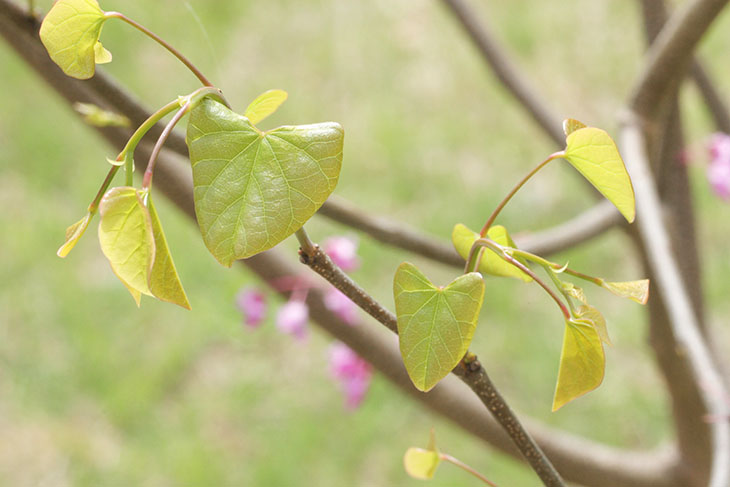
A lot of the roots had spread out into areas I couldn’t dig them from and thus got left behind (which probably means the tree will reappear back in the original location too,) so I’m pleased that this one seems to have taken hold. It had served as host for a lot of critters last year, and hopefully will provide more photo opportunities again this year. I might also plant some morning glories at the base and see if I can convince them to climb the tree – maybe this time the hummingbirds will start visiting and I can get some natural-looking shots, instead of mostly at feeders.
Speaking of that, early last week I had filled a hummingbird feeder and set it out, figuring I might be a little early for this area but may as well be welcoming when they arrive. It was gratifying to see it in use within a day – I guess I wasn’t too soon after all. Since I likely beat any of the neighbors in getting a feeder up, perhaps I convinced them to build their nest close by. I witnessed a few mating display flights, and it didn’t take long before at least three were squabbling over feeding rights, as they tend to do, so I quickly put up two more feeders. I have yet to see a nest, even though I know they’ve been within a few dozen meters, but I don’t find this surprising; the nests are ridiculously small and usually buried well in the tree canopy for protection. One day I intend to find one I can watch. No pics of these yet – I haven’t staked out a feeder for long enough, and they’re still a bit spooky, but give me a little more time.
I’ll close with yet another image of one of the green lynx spiderlings (Peucetia viridans,) this time with the first observed meal of the year – which may well be its first meal since late fall. It appears to be the same species of filmy dome spider (Neriene radiata) from earlier, but I don’t think that same one seen in those photos, despite this being taken not 15 cm away – I believe that one was bigger. Either way, it’s been interesting watching these tiny green hunters weather out the fiercer-than-average winter on largely the same perch seen here, which was at times covered in ice (I have no idea where they scampered off to when that happened.) It might be cool if I found a way to tell individuals apart, just to chart their progress, but that might be understandably difficult. Still, get used to seeing them, because I’m sure more images are coming.
